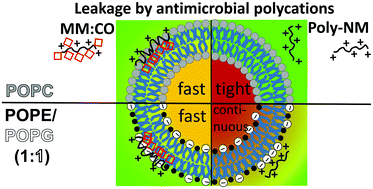Hidden complexity in membrane permeabilization behavior of antimicrobial polycations†
Abstract
A promising alternative to classical antibiotics are antimicrobial peptides and their synthetic mimics (smAMPs) that supposedly act directly on membranes. For a more successful design of smAMPs, we need to know how the type of interaction with the membrane determines the type of membrane perturbation. How this, in turn, transfers into selectivity and microbial killing activity is largely unknown. Here, we characterize the action of two smAMPs: MM:CO (a copolymer of hydrophobic cyclooctyl subunits and charged β-monomethyl-α-aminomethyl subunits) and the highly charged poly-NM (a homopolymer of α-aminomethyl subunits). By thorough characterization of vesicle leakage experiments, we elucidate complex membrane perturbation behavior in zwitterionic or negatively charged vesicles. Vesicle leakage data does not entirely agree with the growth inhibition of microbes. Our ensemble of advanced membrane permeabilization approaches clarifies these discrepancies. Long cumulative leakage kinetics show that the two smAMPs act either by transient leakage or by rare stochastic leakage events that occur at charge neutralization in the sample. We determine the strengths of individual leakage events induced by the smAMPs in membranes of various compositions. These strengths indicate changes in leakage mechanism over time and concentration range. Thus, our sophisticated analysis of vesicle leakage experiments reveals a fine-tuned flexibility in membrane permeabilization mechanisms. These details are indispensable in judging and designing membrane-active compounds.



 Please wait while we load your content...
Please wait while we load your content...